
Song/Yuan Trade Ceramics
Yue green wares continued to be exported till around mid Northern Song period. Guangdong kilns continued to benefit from its proximity to Guangzhou port during this period. Two of the most notable Guangong kilns are Xicun (西村) near west of Guangzhou and Chaozhou Bijiashan (笔架山)。The kilns produced large quantity of qingbai/white and green wares for the overseas market. The greenwares are essentially modelled after the products of Yue and Yaozhou kiln. Many are decorated with carved/molded floral decoration. The Qingbai wares are essentially copies of those made in Anhui Fanchang (安徽繁昌) and Jingdezhen Hutian kilns. Overall, the products of Chaozhou Bijiashan are finer and of better quality than that from Xicun. Most Guangdong kilns ceased production by early Southern Song period.

Song Guangdong Trade Ceramics in Exhibition organised by Singapore Yinliuzhai Ceramics Society & Rao Bao Tang
Another important milestone during Northern Song is the emergence of Jingdezhen and Longquan kilns. By Southern Song they became market leaders who introduced many innovative new classic products treasured by subsequent generations of collectors.
During late Northern Song, Longguan kilns expanded production of green wares and by Southern Song period became the most important greenware production centre in Southern China. Longguan greenware, more widely termed celadon in the West, became a major Southern Song/Yuan brand which was widely demanded by overseas consumers. The most distinctive and desired feature of Longquan is its distinctive thick jade-like glaze which is attained through multiple application of glaze.

Song/Ming Celadon wares in Exhibition organised by Singapore Yinliuzhai Ceramics Society & Rao Bao Tang
Based on the latest archaeological findings, Anhui Fanchang kiln was the first to introduce Qingbai glaze during the 5 Dynasties period. However, it was Jingdezhen which became famous for Qingbai glaze during the Northern Song period. Qingbai continued to be produced till the Yuan period. In the first half of 14th century, Jingdezhen also introduced a varient of Qingbai glaze termed shufu. Instead of the more icy and transparent Qingbai glaze, this type is more opaque and goose egg white colour tone.

Song/Yuan Qingbai wares in Exhibition organised by Singapore Yinliuzhai Ceramics Society & Rao Bao Tang
Sometime during the first half of 14th century, Jingdezhen also introduced wares decorated with under glaze cobalt blue/copper red. Jingdezhen became the other major Song/Yuan porcelain production centre and by the Ming period the undisputed Porcelain production capital of China.

Yuan blue and white/coppeer red Exhibition organised by Singapore Yinliuzhai Ceramics Society & Rao Bao Tang
Guangzhou's position as the main port of exit was replaced by Quanzhou in Fujian during the early Southern Song period. We see a repeat of past production trends with many kilns along Fujian Minan (闽南) coastal regional sprouting up and producing porcelain for the export market. Fujian products of this period were mainly copies of Longguan and Jingdezhen wares. Important kilns excavated included those in Nanan (南安), Anxi (安溪),Tongan (同安), Cizao (磁灶) and Dehua (德化). Dehua produced mainly qingbai/white wares while the rest mainly greenwares and qingbai/white wares. Cizao kiln also produced lead glazed green and brown vessels. Probably the only porcelain product which Fujian can deservedly claim fame is Jian Temmoku bowls. Jian temmoku with hares' furs or oilspots are treasured by tea connoiseurs. Many Fujian coastal kilns also produced temmoku bowls. Besides Jian kiln, Dongzhang (东张) kiln in Fuqing (福清) was the largest temmoku production site. Temmoku bowls were found in large quantity in Japan but comparatively few in Southeast Asia.

Song/Yuan Fujian ceramics in Exhibition organised by Singapore Yinliuzhai Ceramics Society & Rao Bao Tang
Guangdong ceramics
Two of the Song Guangdong kilns which have been surveyed and information more widely available are Xicun (西村) near the west of Guangzhou and Chaozhou Bijiashan (笔架山). Between them, they produced most of the types found in Guangdong. Xicun produced mainly green wares wares and small quantity of Qingbai, brown and low-fired green lead glaze vessels. Based on the survey of the shards at the kilns, Chaozhou Bijiashan produced over 40% Qingbai wares and the rest mainly celadon and brown/black glaze wares. In general, many of the products showed the influence of Yue /Yaozhou greenware and Jingdezhen Qingbai wares.
Xicun is located about 5 km Northwest of Guangzhou. The kiln was located in the area called Huangdi Gang (皇帝岗), i.e. emperor's hill. A report was published in the 1950s and listed 15 types of vessels including dishes, bowls, cups, ewers, jars, lamps, boxes, pillows, bird whistles and other miniature figurines. The Guangzhou shi Museum has a permanent display of a group of Xicun shards excavated from Huangdi Gang.
Northern Song Xicun wares displayed in Guangdong Shi Museum
Examples of excavated Xicun wares from Philippines Butuan and Malaysia Tioman Islands were published in the 1980s. In 1989 a wreck discovered near Pulau Buaya of the Lingga archipelago (about 90 km south of Batam) carried a substantial quantity of Guangdong ceramics and small quantity of Jingdezhen and possibly Fujian ceramics. However, none of three most notable Xicun wares, i.e. those with painted, carved floral motif or iron-brown spotted vessels were in the cargo. But in 2012, quite a few large Xicun bowls with iron-brown painted or carved floral motif surfaced in the Singapore antique market. They were salvaged from 2 shipwrecks, one in the Riau archipelago and the other near the Belitung Island.
The big celadon (grayish green) bowls (dia. 33 and 23 cm respectively) have boldly painted iron-brown floral motif. The bigger version has well formed and fine paste foot.
Some celadon bowls with iron brown painted floral motif from the Riau wreck
 |
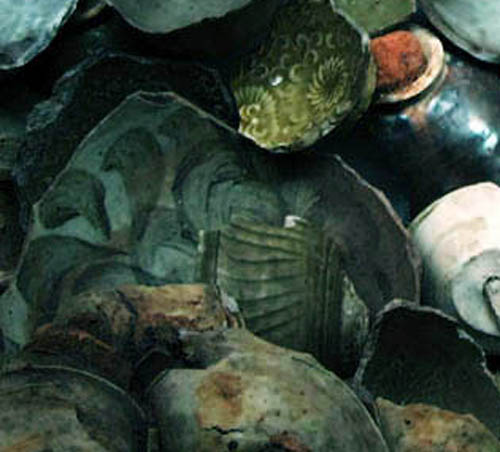 |
|
Examples of iron-brown painted motif on pillow and fragment of a bowl exhibited in Guangdong shi museum |
|
Guangdong potters also copied a repertoire of motifs from Northern Song Yue/Yaozhou wares. The motif is executed by using one or combination of carving, incising or combing techniques.
 |
 |
| Two examples of Yue style carved/combed motif from Xicun kiln in Guangdong shi museum | |
Xicun also produced a distintive type with carved floral motif. The outline of the flower is formed by punched like arcs or arc-like mark left by the thumb nail. It showed that the potters did not just copy but also introduced distinctive elements in the carving technique. The bowls have light grayish green glaze and grayish paste.
|
|
|
|
|
The flower has the outline formed by punched-like arcs. Example came from the "Belitung" wreck |
||
|
|
||
|
Example from Xicun Huangdi Gang exhibited in Guangdong shi Museum |
||
The kilns in Xicun, Yangjiang (阳江) and Huizhou (惠州) also produced a form of Yaozhou style impressed floral motif bowls. As compared to the Yaozhou counterpart, the impressed motif from the three Guangdong kilns are more crude with outline not as crisp as those from Yaozhou.
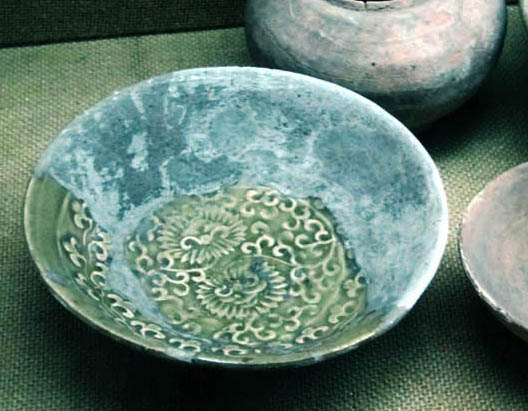 |
 |
|
Examples of Yaozhou style impressed floral bowls from the Xicun kiln in Guangdong shi museum |
|
|
|
 |
|
A Xicun/huizhou celadon dish from a wreck from Indonesia |
|
|
|
|
|
Example of Xicun kiln Yaozhou style shallow bowl |
|
Another popular decorative element is elongated 's' lines that are carved on the outer wall of vessels. In the rougher version, the 's' lines are more akin to carved slanting vertical lines. Those from Xicun has a light grayish green glaze and Chaozhou more varied consisting of grayish green if the paste is grayish and more clear whitish/light whitish blue/yellow if the paste is white.
|
|
|
|
Carved 's' shape lines on a Xocin bowl exhibited in the Guangdong shi museum
|
|
|
|
|
|
Example of shallow bowl with light grayish green glaze from Xicun kiln. On the inner wall, there is carved/combed floral motif. |
||
|
|
|
|
A more thinly potted and more refined version with greenish glaze from Indonesian. This example is more likely from Chaozhou kiln |
|
Wares with lotus petals carved in high relief is particularly popular during the Norther Song period. Both celadon and white/qingbai types are available from Guangdong kilns. Interesting, Xicun also produced a distinctive form with incised lotus petals.
|
|
|
|
A
white glaze bowl with carved lotus petal. Mostly likely from a
Chaozhou kiln.
|
|
|
|
|
| An example executed using incised from the Xicun kiln. The style is similar to that on the lower body of the Xicun phoenix head ewer. | |
Chaozhou Bijiashan kiln also produced a form of Qingbai bowls/plates with abstract floral executed in a distinctive fast and fluent incised lines. Most of such products are more likely from the Chaozhou region although small quantity was known to be produced in Xicun kiln.
|
|
|
|
An example with light grayish green glaze from the "Belitung" wreck. A similar example was found the Chaozhou Bijiashan excavation. |
|
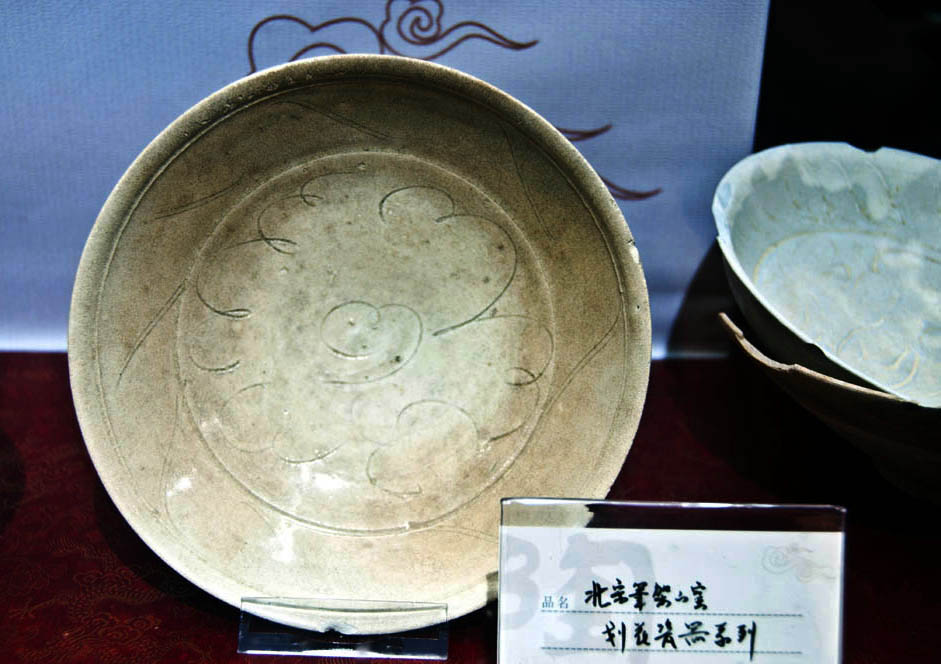 |
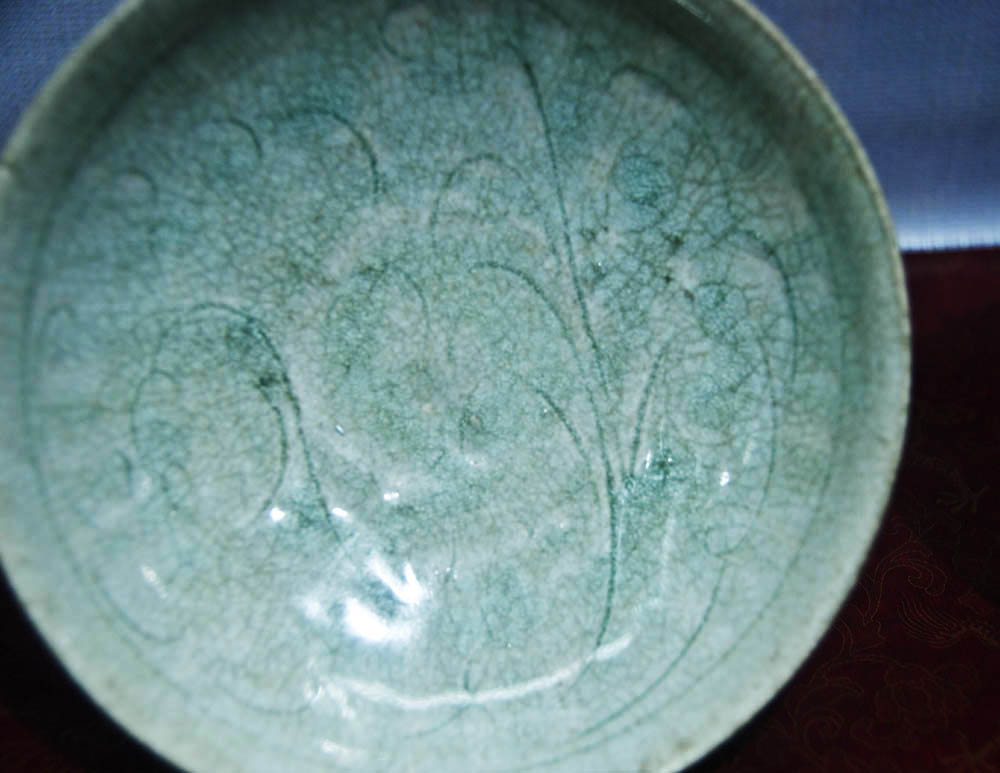 |
|
Two incised floral motif from the Chaozhou Bijiashan kiln exhibited in an exhibition on Chaozhou wares |
|
Guangdong kilns also produced a distinctive form of bottle with ribbed neck. There are versions with lobed globular body. Most has qingbai or celadon glaze or dark brownish glaze. Besides bottles, jarlets with iron-brown spots/splashes were also produced in large number.
|
|
|
 |
 |
|
Two xicun ribbed neck bottles with iron spots decoration |
|
|
|
 |
 |
|
Examples excavated from Xicun kiln shown in Guangdong shi museum
|
|
|
|
|
|
|
|
|
Three Chaozhou kiln Qingbai examples which has whiter paste and clear Qingbai glaze. The potting and the foot is usually more refined.
|
|
Another well-known Xicun vessel is phoenix head ewer. The more common form has a light grayish green celadon glaze which is usually decorated with carved floral motif. There are also those glazed with a qingbai glaze.
 |
 |
| Phoenix head celadon glaze ewer. It also has the typical Xicun floral decoration with punched arcs. Artifact was excavated in Central Vietnam | |
Phoenix head ewers were also made in Chaozhou kilns. They have qingbai glaze which is light bluish in colour tone and has whitish paste. The features of the phoenix head are also different.
 |
|
|
A qingbai phoenix head from Chaozhou kiln |
A qingbai phoenix head vase in Hainan Museum |
Chaozhou Beijiashan also produced a distinctive white glaze fish-shaped ewer. Another interesting product from the Bijiashan kilns is Qingbai/white female figurines.
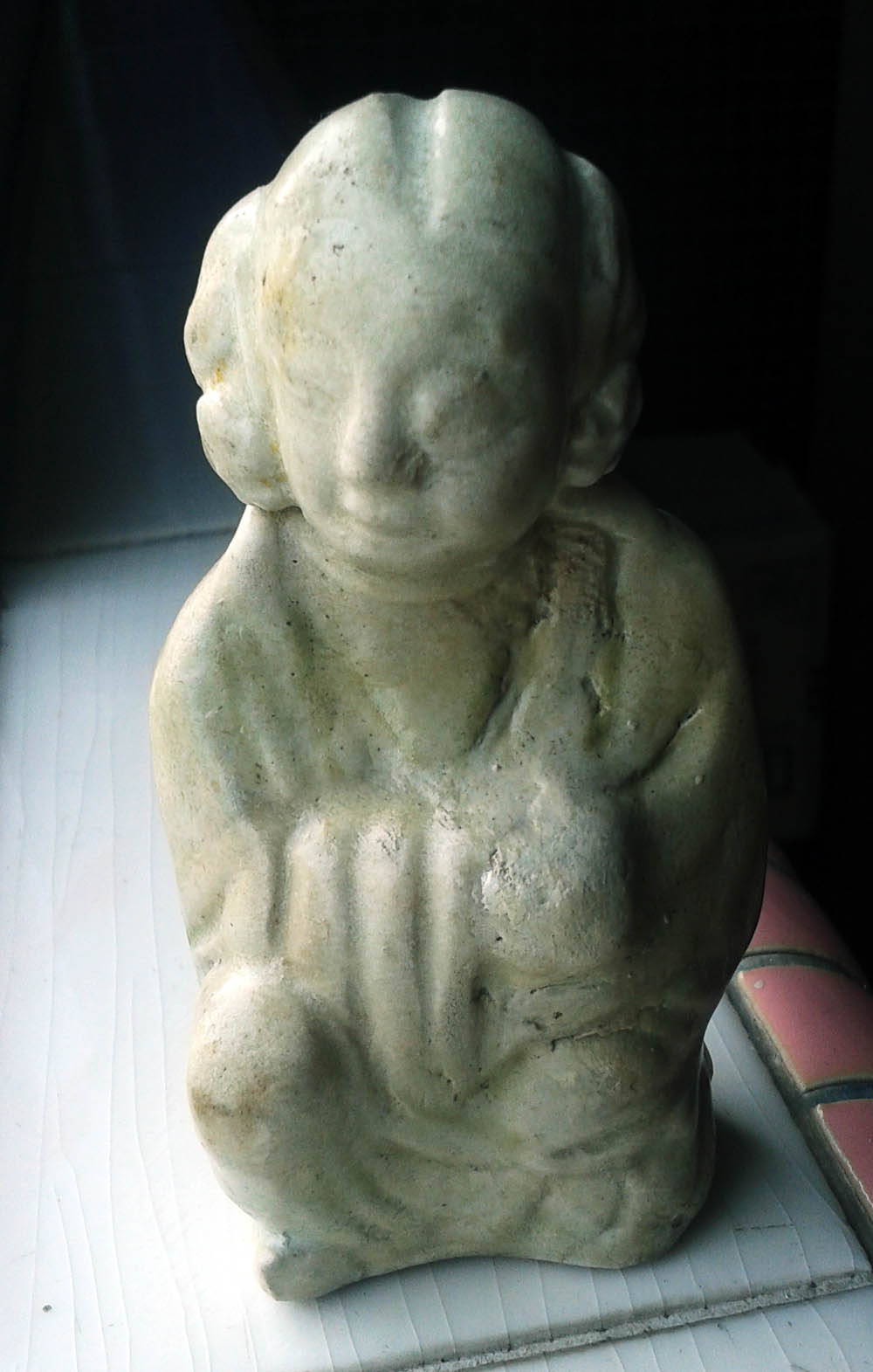 |
 |
Guangdong kilns also produced bowls with a thickened lip. The bowls varied in colour tone from grayish green to light bluish tone. They are generic product and not easy to attribute such bowls to a particular kiln as they were produced in many kilns in China. The Pulau Buaya wreck also carried large quantity of such bowls.
|
|
| A thickened lip bowl from
Xicun Huangdi Gang |
|
|
|
|
An example of thickened lip bowl from Indonesian wreck |
|
Chaozhou Bijiashan kiln also produced a form distinctive form Qingbai tall cover boxes. Similar types were also produced in the Fujian Nanan (南安) kiln.
|
|
|
|
|
|
|
Various forms of Qingbai tall cover boxes |
|
Brown glaze basin-shape vessels, many with impressed flower motif on the interior, are another popular export from Guangdong. Xicun kiln was known to be the producer of many such vessels.
|
|
|
| A brown glaze basin-shaped vessel with impressed flower from the Indonesian wreck | |
In the Pulau Buaya wreck, there were some quantity of big storage jars with dark brown glaze. The shoulder has impressed floral motif. Such jars could be found in many of the Southeast Asian ceramics collections. Many are products from the Nanhai Qishi kiln. There are also those with impressed Chinese characters such as that indicating the year of production, Zhenghe sixth year (政和六年) i.e. 1116 A.D , identifying ownership Pan Residence (潘宅) and etc.
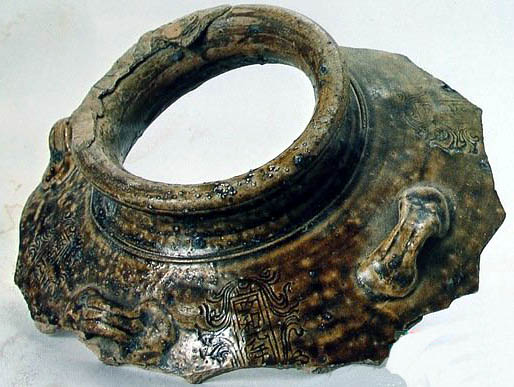 |
| Jar fragment
from Nanhai Qishi kiln and with Zhenghe 6th year mark
|
|
|
||
| Dark
brown glaze big jar with impressed floral motif from the Nanhai Qishi
kiln and recovered from the Pulau Buaya wreck
|
|
|
|
| Rubbings of the impressed markings and drawing of the storage jar based on the finds in the Nanhai Qishi kiln | |
Certainly there are other Guangdong kilns that produced large jars and generally have similar glaze characteristics. Based on current level of information, it is difficult to give a specific kiln attribution. Some examples are illustrated below.
 |
 |
|
Two examples of other shape of brown glaze jars from the Cirebon wreck dated to beginning of Northern Song period |
|
Jingdezhen Qingbai wares
Jingdezhen qingbai wares were first produced during the Northern Song period. The colorant of the qingbai glaze is iron oxide in the raw materials used to make the glaze. The glaze composition is also high in calcium oxide which enable a bluish tinge to develop when fired under reduction atmosphere. The glaze has a light yellowish tone if not properly reduced during reduction firing.
Qingbai wares most probably became an export product only from mid-Northern Song period onward (2nd quarter of 11th century onward). Those from the Northern Song period has a jade-like light bluish tinge. The typical bowl has a small and tall foot. The base is thicken to support the weight of the vessel. It seats on a disc during firing in the kiln. The wall of the bowls were thin. They were trimmed on a turning wheel after throwing on the potter's wheel. They are either plain or decorated with lightly carved/incised floral motif.
Song Qingbai bowl fragments
|
|
|
|
|
|
| The lightly carved floral motif and the distinctive short combed dots. It has the typical tall foot. This bowl was recovered from a Northern Song wreck in Indonesia | |
There is quite a range of vessels produced: including bowls, dishes, ewers/warmers, tea cups/stands, censers, pillows, cover boxes, chess boxes and all sorts of figurines.
Further technical improvements were made during the 12th Century (late Northern Song to Mid Song period). There was effective control of the kiln reduction firing atmosphere. There were more varied carved/incised decorations including chrysanthemums, lotus, waves, infants among foliage, fish and etc. As compared with the carving of the earlier period, the cut is sharper and deeper. The foot of the bowl is typically shallower and smaller.
|
|
|
|
|
|
| Late Song/Early Song bowl. The carving is more elaborate and deeply cut. As compared with the earlier period, the foot is also shorter. It was fired sitting a clay disc on the outer base. A brown patch is usually visible as a result. | |
The Nanhai shipwreck dated to the early southern Song period also carried certain quantity of Jingdezhen fine qingbai wares. The bowls and dishes are thinly potted with forms inspired by silver wares.
|
Late Northern/Early Southern Song cover box with the factory mark |
The inverted firing in saggar was introduced during the later part of 12th century. As a result, the mouth rim was left unglazed and the foot of the bowls and dishes are typically shallow. It makes sense from the production point of view. Such stacking method allows more vessels to be placed in the saggars. This method economized and maximized the usage of kiln space. The bowls/dishes were predominantly decorated with molded motifs.
 |
|
Southern Song dish with impressed fish and lotus motif |
During the early Yuan period, the inverted method of firing was still in use. However, the quality of the products was inferior to those of the Southern Song period. The Yuan period especially from 14th century onward is characterized by vessels which are more thickly potted. Vessels such as vases, ewers and jars/jarlets were made using parts that were formed by molding. The body is usually decorated with molded motif. The use iron-brown splashes was popular on vessels for the overseas market.
Yuan qingbai wares were particularly popular in the Japanese and Southeast Asia market. More varied and interesting vessels form were introduced: such as vases with pedestal, various form of flattened, gourd or pear-shaped ewer with molded decoration. Decoration formed by trailed beads was also in vogue. In the Sinan shipwreck dated about A.D 1325, a substantial quantity of the above mentioned types of qingbai wares were salvaged.

Yuan Qingbai wares found in the Sinan wreck
Many Yuan qingbai wares have also been excavated in the Philippines and Indonesia. Below few examples were found in Indonesia.
 |
 |
| Yuan Qingbai Gourd shaped ewer with a lizard like handle | |
 |
| This gourd shaped ewer with iron brown splashes was also formed by molded parts. A popular items mainly manufactured for the overseas market. |
Jingdezhen Shufu
During the Yuan dynasty, a new glaze formula with reduced glaze ash proportion of 10% as compared with about 30% in Yingqing glaze was introduced. It has a higher viscosity and enables thicker glaze application. Due to reduced fluxing agents in the glaze composition, the finished product has more un-melted quartz particles and fine silica in the glaze. They scatter light and hence the glaze looks opaque and matted with a softer white or white/light bluish colour tone. The term luan bai (卵白) meaning duck egg white was used to describe such colour tone. Such wares consisting of mainly bowls and dishes, were made in Hutian kilns located outside Jingdezhen. Some of the bowls and dishes have molded relief motif and the two Chinese characters shu fu (枢府) meaning "Privy council". However, majority have just either plain or molded relief motif of flowers, dragon or phoenix. Such vessels are typically more thickly potted and usually there is pooling of glaze at the inner and outer mouth rim.
The commencement date production of shufu wares is still uncertain. In the Sinan wreck of about A.D 1325, there were some shufu wares. A small number of shufu wares continued to be made in the Hongwu period. The famous Yongle Tianbai [甜白] was most likely the result of further improvement to the shufu glaze formula.
|
|
|
|
A typical Shufu Luanbai bowl with thick and more opaque glaze |
|
Yuan Blue and white/copper red
So far, no Yuan blue and white from shipwreck or excavation has a dating earlier than A.D 1330. In the Sinan shipwreck dated about A.D 1325, there were some shufu, iron-oxide decorated wares and a plate decorated with copper red calligraphy from Jingdezhen. But no blue and white was found. In Jiangqi's (蒋祈)writings Taoji (陶记)widely regarded as written between A.D 1322 - 1325, there was no mention of blue and white.
From published sources, so far the earliest blue and white was a sherd with cobalt blue inscription and a date yuantong (元统)3rd year (A.D 1335) mentioned. It was excavated in Jingdezhen Daijia nong (景德镇戴家弄). There were quite a number of sherds with inscription indicating cyclical or Zhizheng date excavated in Jingdezhen. All are dated to the A.D 1340s.
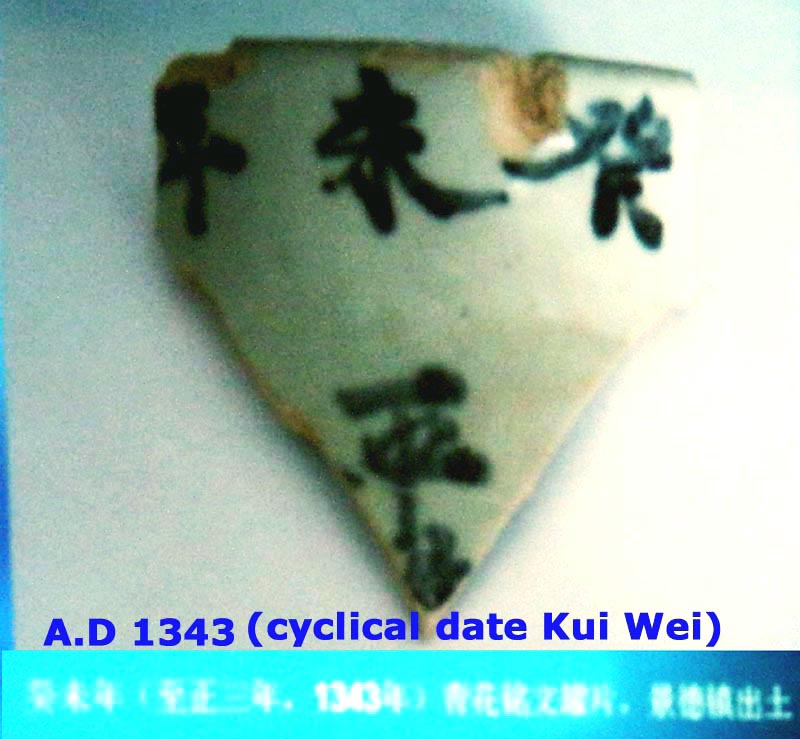
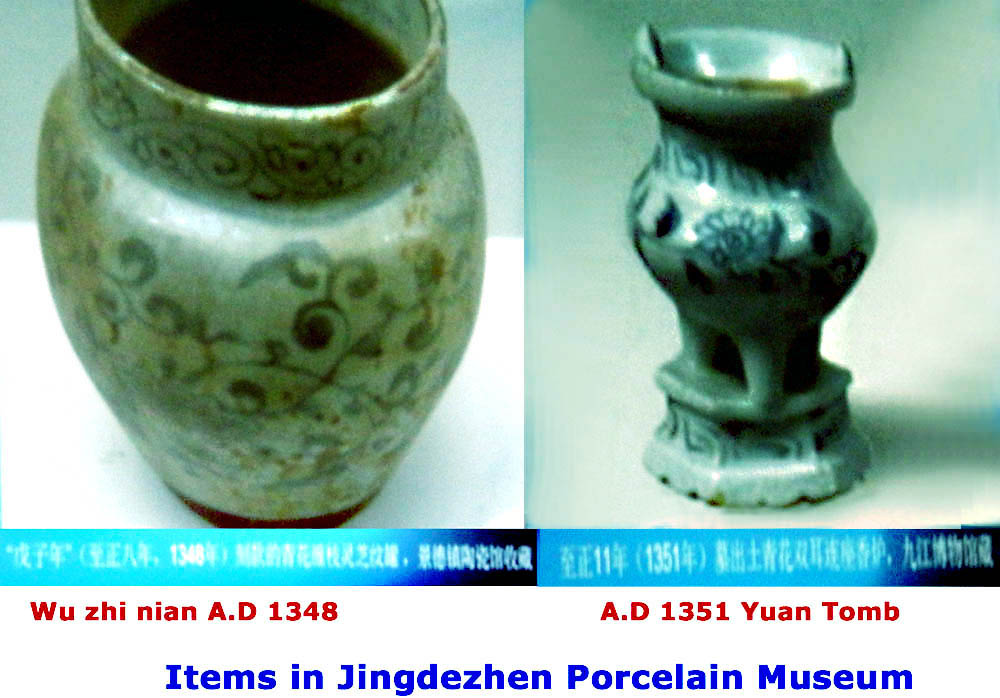
Hence, so far evidence indicates that production of Yuan blue and white most probably started around A.D 1330.
Kiln sites producing Yuan blue and white have been located in several sites in Jingdezhen and Hutian. In Hutian, kiln sites located south of the river Nan were found to specialize in the production of large vessels, such as large plates, jars and vases, with mulit-layered motifs which were mainly found in Middle East collections. Kiln sites located north of the river produced mainly small vessels such as jarlets, bowls and dishes with simple decoration. They were commonly found in Philippines and Indonesia. The stratification of the kiln site, located South of the river Nan, showed the blue and white layer above the layer of shufu glaze vessels. Although the actual date of production of the blue and white could not be ascertained, they most likely made their appearance later than shufu wares.
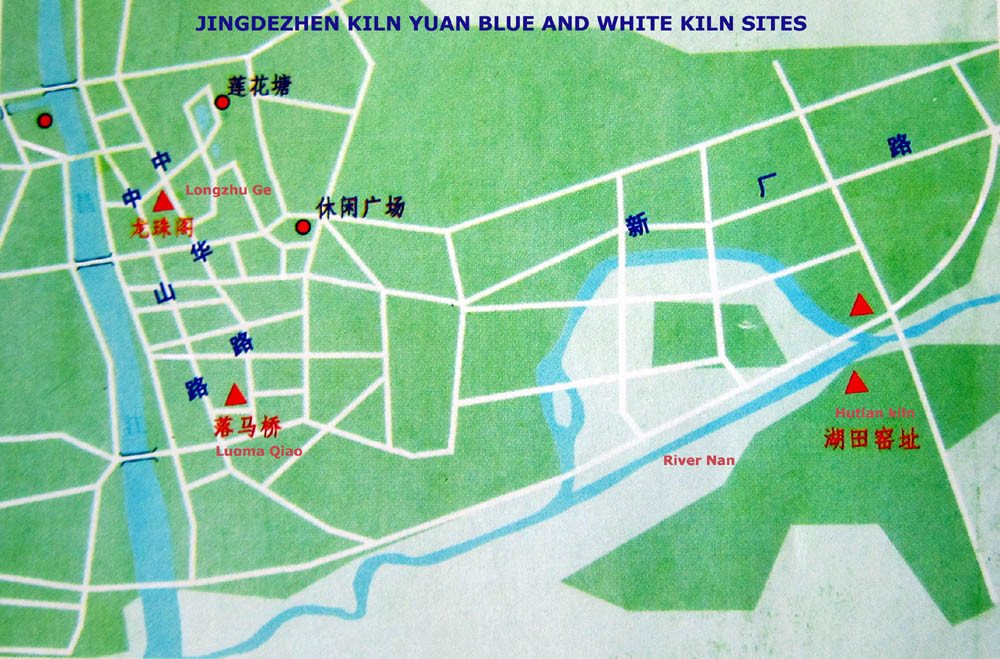
In Jingdezhen, the site at Luoma Qiao (落马桥) were found to produce a large variety of vessels form such as including plates, cups, vases, jars and figurines. There were also vessels such as jar and Yuhuchun vase decorated with under glaze copper red motifs. A fragment of small bowl with over glaze red/green motif was also recovered.
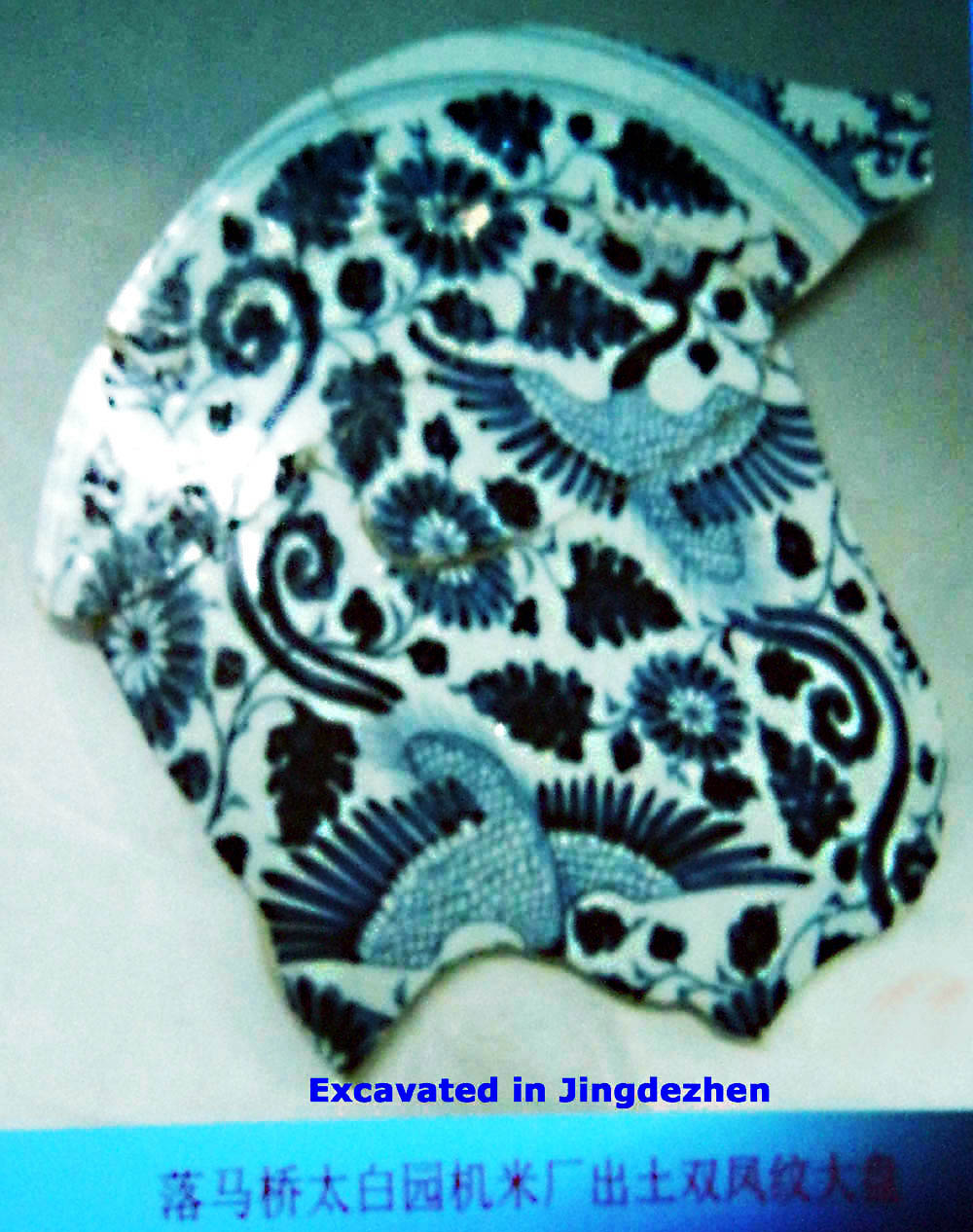
The site at Longzhu Ge (龙珠阁) specialized in production of vessels for the palace. The jars with dragons are drawn with 5 claws, typically only permitted for imperial use. Some of the vessels were glazed in blue or turquoise and decorated with gold motif. In Yuan Dianzhang (元典章), it was decreed that the use of gold gild by common folks was prohibited.
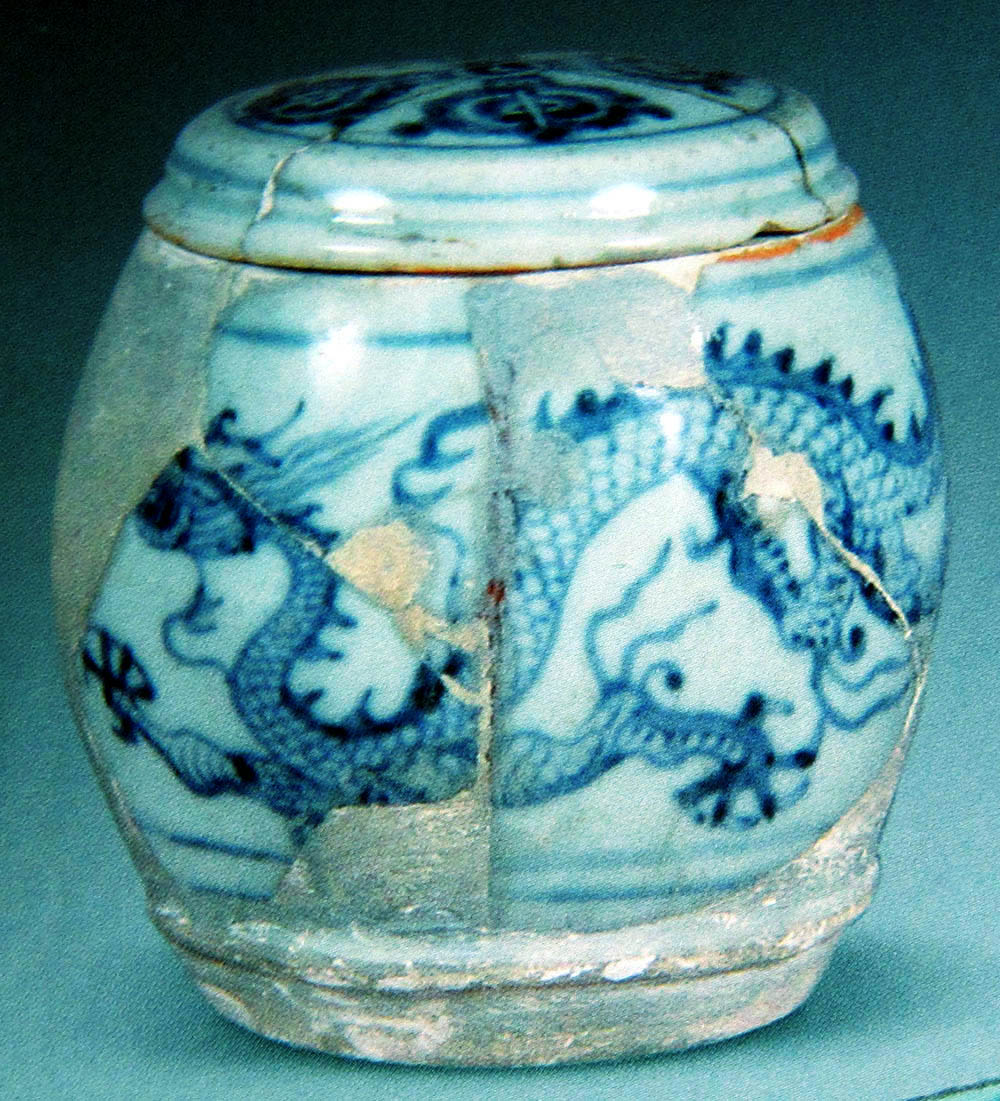
Jar with 5 claws dragon from Longzhu Ge kiln site
The typical high quality Yuan blue and whites are in the form of large plates, guan jars, rectangular flat vases, meiping/yuhuchun/gourd-shape vases and big bowls. The best collections are now in Topkapu Saray in Istanbul Turkey and Ardebil in Iran Bustan in Tehran. The motif and composition on the pieces was similar to that of the David Vase. It is termed Zhizheng type. The quality is consistently very high and typically with different motifs organized within separate band. For example, the David vase has 8 bands of motifs. The glaze on the vessel is also more transparent with a tinge of blue. It is very different from the Qingbai or shufu glaze found on those small blue and white vessels for the Southeast Asia market.
The varieties of motif are numerous ranging from many different type of flowers and floral scrolls, dragon, phoenix, crane, heron, mandarin duck, fish, mystical animals, Buddhist precious objects, clouds, waves, human and landscape depicting scene from ancient episodes from the 3 kingdom and Han Dynasty. The use of bands to organize motifs is not new and can been seen in earlier period such as those on Song Cizhou wares. What is interesting and striking is the way the potter squeezed so many varied motifs into one composition on the vessel. Visually it looks crowded as if the designer is adverse to leaving empty spaces. However, they are well-organized and do not appear messy. Another interesting approach is having some of the motifs reserved in a blue background. One distinctive and refreshing element also worth noting is having motifs within cloud collars.

Besides the above high quality types, many small ewers, small jarlets, cups and bowls with a Qingbai or shufu glaze were excavated in Southeast Asia countries such as Philippines and Indonesia . The design was generally simple, consisting of floral /cloud motif in greyish cobalt blue executed using calligraphic strokes.
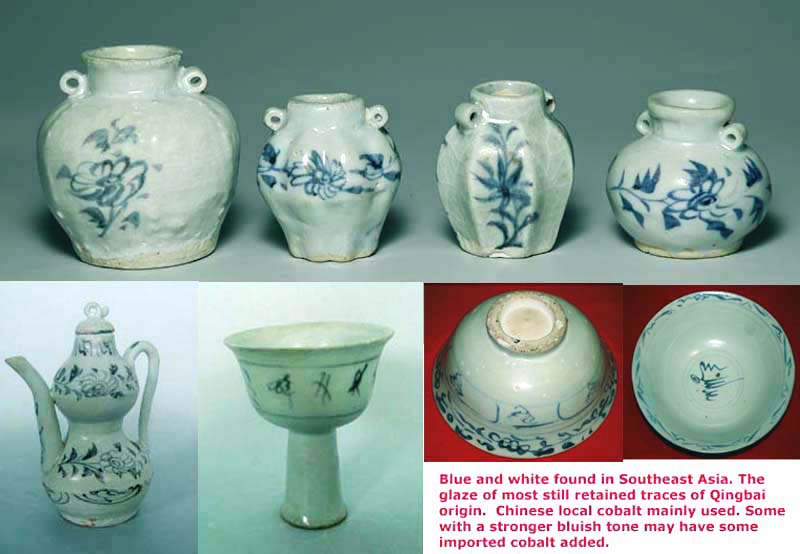
Such items were produced in Hutian kiln located South of River Nan
The blue and white exported to Middle East were generally of high quality. However, it is a mis-conception that those exported to Southeast Asian countries are low quality blue and whites. Excavations in Trowulan (in Java), the former capital of the Majapahit empire in Indonesia showed that quite a number (including vases and big jars) were of high quality.

Visually, it appears that two types of cobalt are used for Yuan blue and white. The typical high quality type has a strong and vibrant shade of blue. The blue on the small pieces appears greyish in tone. Generally, it is believed that the former was decorated with imported cobalt and the latter local cobalt. The below photos gives an idea of how local and imported cobalt is thought to appear visually.
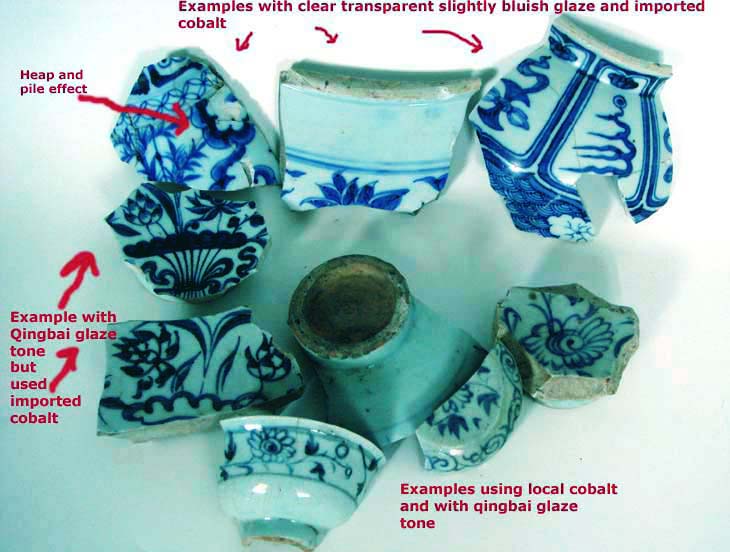
Scientific analysis shows that the local cobalt is high on manganese and low of iron oxide. The imported cobalt is the reverse, i.e.. high on iron oxide and low on magnesium. The high manganese is believed to render the grayish tone to motif drawn using local cobalt. However, recent scientific tests have consistently revealed that the cobalt used on those Yuan blue and white which appear greyish in colour tone is also imported cobalt. It seems that other factors such as the firing temperature, the atmosphere and quality of the cobalt may have contributed to the greyish tone. The Chinese called the imported cobalt sumali [苏麻离青] or suboni [苏渤泥青] blue. Some suggested sources of the imported cobalt are Kashan in Iran or Samarra in Iraq.
Besides blue and white, there were also significant number of the vessels decorated with under glaze copper red. Generally the decoration found on copper red pieces are more sketchy and less elaborate. Copper oxide is highly volatile under high temperature and it is difficult to find pieces with good red colour.
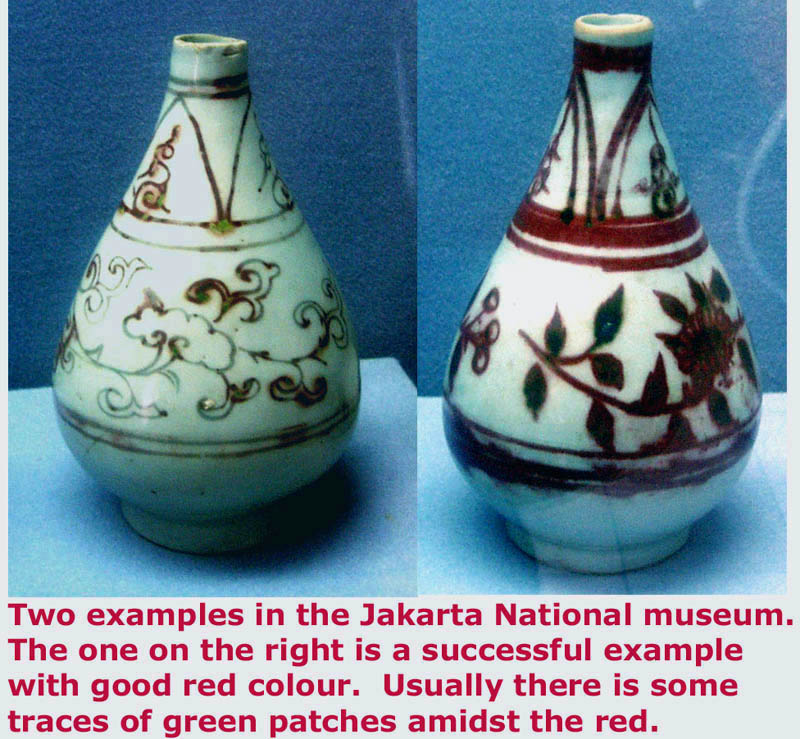
Longquan Celadon
The kilns producing Longquan celadons were located in southern Zhejiang province, covering ten counties with most kiln sites located at Longquan (龙泉), Qingyuan (庆元), Yunhe (云和), and Lisui (丽水). Longquan had the most kiln sites with those located at Dayao and Jincun produced the best quality Longquan wares during the Song, Yuan and Ming period.

Present day Dayao village
Longquan is situated in a mountainous region and access to the outside world is mainly by the river Longxi (龙溪). Longxi is the upper stream of Ou river (殴江) which flows through Wenzhou, a major port. According to an ancient text, Zhi tan ji (治滩记) by Gong Yuan (龚原), works to improve and remove the obstacles along the longxi river to facilitate navigation was finally completed in the 7th year of Yuanyou (元祐七年), ie 1092 A.D. Prior to that, Longxi was notorious for the numerous treacherous shoals, rapids and water falls which made navigation dangerous. With the smooth access to the Wenzhou port, local and overseas markets were open to Longquan wares. It was the turning point for the Longquan ceramics industry. From then onward, there was increased production and improvement to quality to the ceramics wares. Longquan wares finally became a major international brand by the Late Southern Song period.
Ceramics production in Lonquan commenced in Jincun (金村) during the Northern Song period, with proposed date ranging from mid 10th to mid 11th century. The glaze of the early products is transparent light green in tone and is essentially Yue inspired. They were produced for local consumption.
By Mid Northern Song, the Longquan potters produced a distinctive form of greenware. The biscuit is light grey to grey in colour. It has thinly applied transparent, glassy glaze with unglaze base. The glaze is generally greyish green to yellowish green but there are also some with light green tone. A typical bowl of this period has carved vertical lines on the external wall and carved/incised floral motif with combed lines/zigzag lines on the interior. An example dated to A.D. 1091, with the vertical lines on the exterior wall was excavated from the tomb of Li Bing couple at Liyang, Jiangsu province. Those bowls with carved/combed motif but without vertical carved lines on the external wall were introduced later. Besides vertical lines, there were also those with stylised carved/combed lotus petals on the external wall. Most Chinese archaeologists date them to Late Northern Song. However overseas findings from habitation sites (such as Dazaifu in Japan) indicates that they were also found during the early Southern Song period.
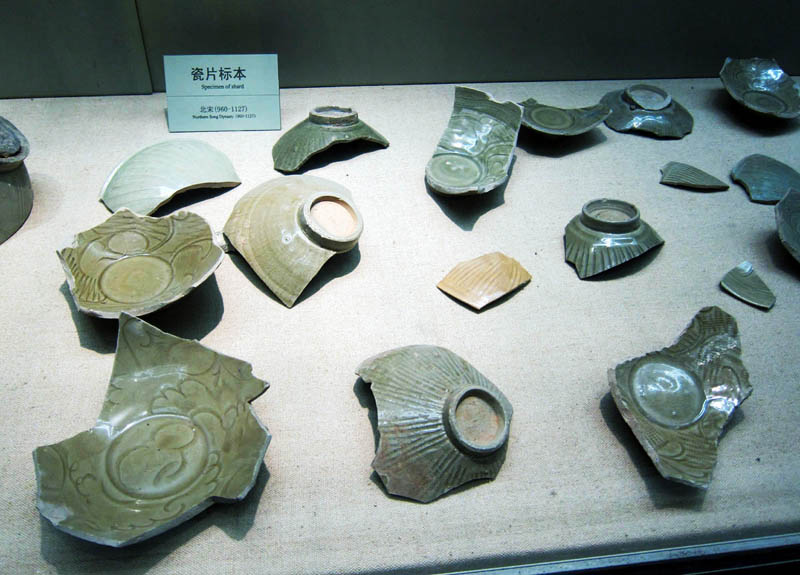
|
|
|
|
This category with combed lines in the lotus leaves are dated to late Song/early Southern Song period |
|
Northern Song period Longquan wares are seldom encountered in overseas ancient habitation and burial sites. They only started to appear in large quantity in the overseas market from the Southern Song period onward. Two distinctive bowls of early Southern Song bowls are those with carved lotus motif on inner wall and those with stylised floral partitioned by 'S" shaped vertical lines. Information from excavation of the kiln sites indicates that bowls and plates constituted the bulk of the production. The Nanhai 1 shipwreck dated to the early Southern Song period carried bowls with similar motifs. The finisihing is fine with silky glaze. They are most likely the products of Longquan Dayao kiln.
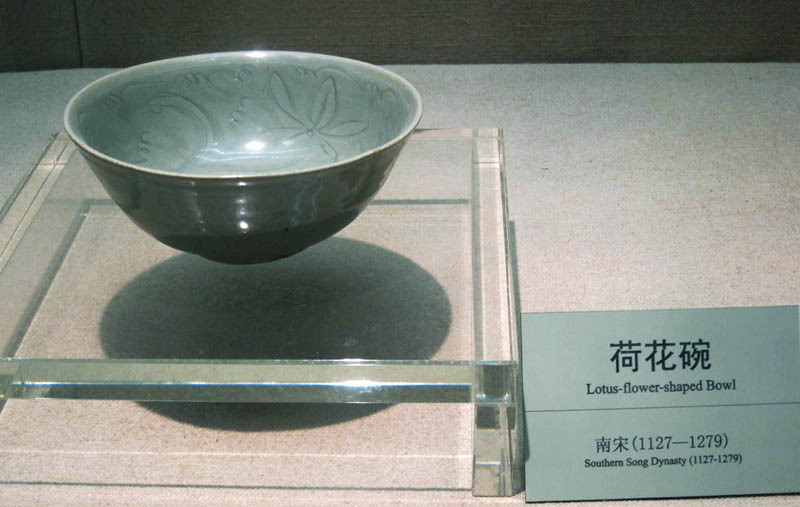
Bowl in Longquan Museum
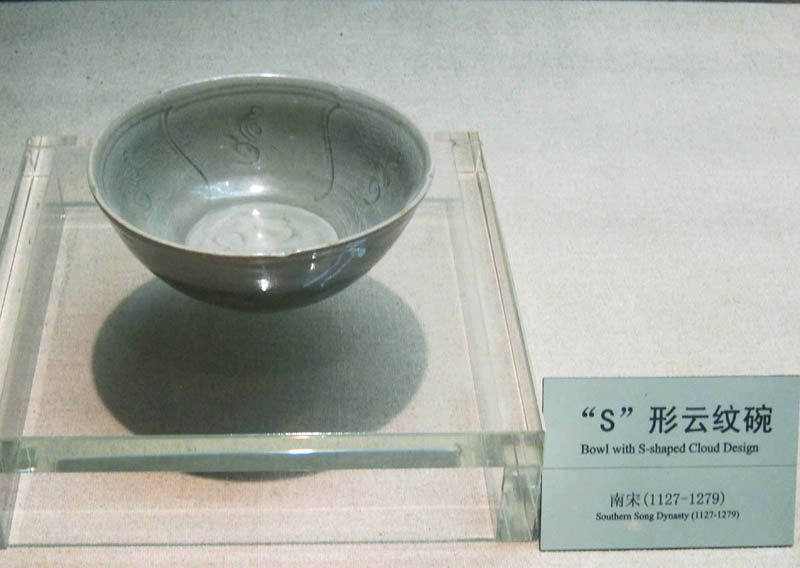
In the Indonesia Jepara shipwreck, there are some bowls with the "s' separator which are similar to those found in the kilns in Da Baian (大白岸) in Eastern Longquan region. They can be distinguished from the Longquan Dayao version by their more crude finishing.
Another popular type of bowl of this period has an impressed inscription on the interior base which reads 金玉满堂 |jingyumantang" (gold jade filled hall) or 河滨遗范 "hebinyifan" (river bank remaining models). The origin of the inscription could be traced to an ancient event. Shun (舜), one of the 5 emperors of prehistoric China, was said to have made pottery in Hebin. The term hebinyifan was in commemoration of the contribution of emperor shun. From pieces found in dated graves, they were produced from around A.D 1180s onward.
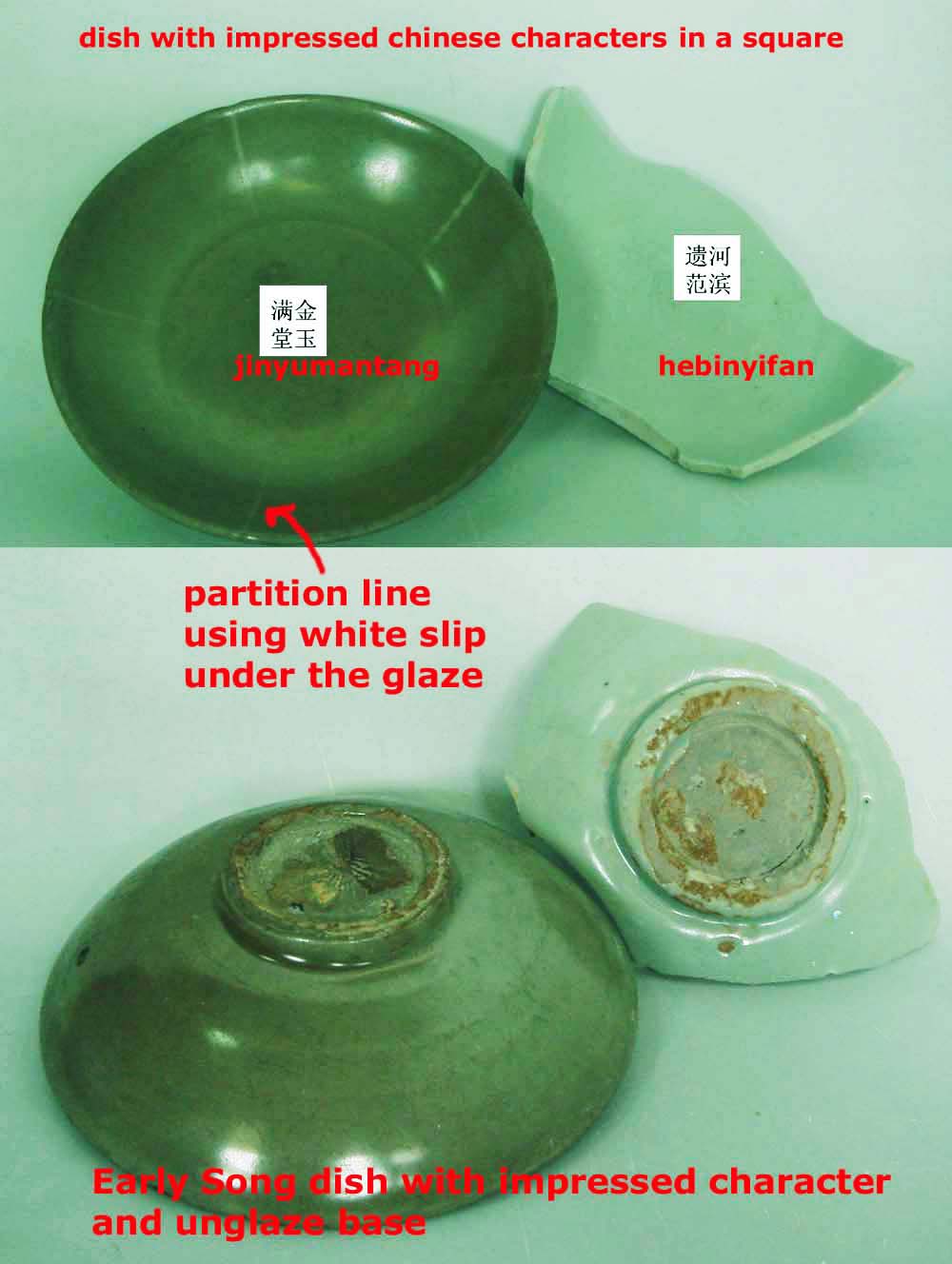
Another very popular Longquan ware is bowls/plates/dishes with lotus petal carvings on the exterior wall. They were introduced sometime around late 12th/early 13th century. The lotus petal has a raised ridge The vessels have thick foot and unglaze outer base. They continued to be produced during early Yuan period.

Examples with broad carved lotus petals and thick unglaze foot
Towards the end of mid Southern Song, Longquan potters introduced a new glaze formula. The traditional lime glaze was replaced by a lime-alkali glaze. Lime-alkali glaze is high on viscosity which induced a softer gloss. To simulate the jade like effect, the thickness of the glaze is thickened by the technique of multiple glazing. Many of the celadon pieces made during the Late Song to early Yuan pieces have multi-layer of glazes. The porcelain stone used for the vessel is mixed with "zijin" (reddish purple) clay. This new mixture enabled a high-quality thin and light body porcelain to be made. Presently, the general view is that the Longquan potters learnt and adopted the technology from the Southern Song Guan wares.
Two types of high quality celadons were produced. One has a thick glaze with white biscuit (with smaller amount of zijin clay", and the second a guan type thick glaze with thinner black biscuit (a higher amount of zijin clay used). The late southern Song to early Yuan period was the golden period of celadon production. The vessels are elegant, with fine and relatively thin potting. The thick jade like glaze is of excellent quality The soft powdery green (fenqing (粉青)) and the plum green (meizhiqing (梅子青)) represented the two most successful glaze which are much treasured by collectors. Both types are fired under reduction firing atmosphere. The plum green is fired at a higher temperature and has clear and transparent jade-green colour. The fenqing is fired at a lower atmosphere and the glaze is less transparent and has a softer glow. During the Southern Song and early Yuan phase, the fenging glaze predominated while meizhiqing was more commonly found during the Yuan period. There are also those with yellowish or orangy glaze which was the result of un-intended oxidizing atmosphere which occurred during firing process.
Longquan wares of this period placed special emphasis on the glaze to bring out the aesthetics of the work. Hence, decorations were used sparingly. Great emphasis is paid on the form, which has clean harmonious contour and raised relief vertical or horizontal lines on the body to create the ribbed effect. The ribbed effect refers to the lighter tone raised lines on the vessels. During firing, the thick glaze flows away from the protruding lines. The glaze is therefore thin and has a lighter colour tone. A good illustration is the below incense burner.

Compared to the earlier phase, there was wider range of vessels . New form of vases, bowls, dishes, ewers, water droppers and incense burners were introduced. They are generally small in size. The most common decorations are raised relief bow string line, lotus petals and applique motifs such as fish peony, dragon, phoenix, flower and etc. There was little use of carved/incise technique as the thick more opaque glaze would obscure the motif.
 |
 |
|
Another two form of incense burner which were first produced at least by the Early Yuan period |
|
During mid 13th Century, those bowls with broader lotus leaves and thick foot were still produced. However, a more refined version with thinner potting and slender lotus petals was introduced and subsequently replaced the earlier type. The foot is thin and well trimmed. Carved lotus petals on vessels was particularly popular during this phase. The interior of the bowl or plate is either plain or has applique motif such as twin fishes, dragon, tortoise or flower on the interior base. Their popularity persisted and continued to be produced in large quantity for export during the Yuan period. It is difficult to differentiate those produced in Late Southern Song to early Yuan phase. Generally, the quality deteriorated after early Yuan period. The finishing tends be rougher with the thicker foot that was more carelessly finished.

A similar bowl dated to 1st year of Deyou (德祐元年) (A.D 1275) was excaved from a grave in Lisui
Different form of dishes which come in different sizes ranging from 12 to 22 cm
|
|
| A similar small ewer with slender lotus petals as above was found in a Jiangxi grave dated 4th year of Jingding (景定四年) ie A.D1263. Notice the joint line at the centre of the body. The body is formed by two parts joined at the center portion. Together with ewer in melon-shaped body, they were very popular in Southeast Asia market during the Yuan period. |
 |
| Southern Song melon shaped ewer. Popular during Yuan and commonly found in Southeast Asia. |
During the 14th century, there was further development in terms of the production technology. The potters were capable of making large vases, jars and plates to meet the needs of largely overseas consumers from Southeast Asia and West Asia. Such large vessels demonstrated the technical competence of the Longquan potters. They were not easy to produce as warping is a constant challenge that needed to be resolved.
 |
 |
|
A big jar with floral motif. Most probably dated to later Yuan period |
|
|
|
| Yuan incenser burner and jarlet. The jarlet with ribbed body was produced in large number for overseas market during the Yuan period |
|
|
 |
 |
 |
| Big Plates with moulded motif such as twin fishes or dragon were introduced during the late Song Period. During the Yuan period, many have the added decorative feature of carved vegetal scrolls on the inner wall | |
During this phase, a new type of bowls with incised parallel lines near the rim was introduced. There were also version with the parallel lines further intersected at interval by slanting lines. The lower outer wall is decorated with lightly incised petals. The footring is thicker and has unglaze outer base. The inner wall of the bowl is decorated with carved floral motif, most commonly lotus flower. There were also other decorative variety such as those with impressed elaborate floral motif on inner wall or floral spray on the inner base. This type of bowl with expanded belly which has a more gradual curve and a flaring mouth rim became the dominant type. It remains a popular bowl form even till present day.
|
|
|
|
|
|
|
|
|
|
Example with impress floral motif on the inner wall |
|
Those bowls and dishes with the slender lotus petals on the external wall continued to be produced. The foot became thicker. A new category with carved floral/vegetal motif on the internal wall was introduced. This additional decorative feature also appeared on those bowls and plates with applique motif on the inner base. Bigger size bowls and plates were also added to the product range. Stem cups also made appearance around this period.
|
|
|
| The footring wall becomes thicker. Finishing of the lotus petals became less refine especiall for the later Yuan pieces | |
|
|
|
There was overseas demands for big bowls and plates. This example has a diameter of 26 cm. There are also those with even larger diameter. |
 |
 |
| A form of small dish shaped like a basin made of bamboo strips was introduced during the Yuan period | |
|
|
|
|
|
|
Some examples of stem cups
Jarlets of various sizes were produced in large quantity to meet the demand of mainly Sutheast Asian consumers. They include those with lugs on the shoulder and those without. The body of the jarlet is either plain or decorated with moulded motif, the most popular being dragon and flower.
|
|
|
|
|
Applique motif in unglaze biscuit form was used quite extensively during the Yuan period. There were also figurines with body parts such as the face and hands in biscuit form. After firing, the unglaze biscuit motif usually oxidised into a orange colour tone. Another decorative element was the application of iron brown spots on the vessels. In some examples below, we can see that both biscuit moulded motif and iron spots were applied on the vessel.
|
|
|
By the second quarter of 14th century, the potters applied single layer glazing for majority of the products. From the economic perspective, this was probably inevitable. The overseas demands was huge and it was economically impractical to use the time-consuming technique of multiple glazing. The glaze is thinner and its colour mainly more pea green/greyish green. To make up for the poorer glaze, the use of carved or impressed motif was prevalent. The more jade-like green glaze which was commonly found in early Yuan wares basically disappeared by late Yuan period. For some low end bowls/plates, an unglaze ring was scraped on the interior base to facilitate stacking during firing. This mass production method was widely adopted by kilns in both Northern and Southern China. Please see below example.
|
|
|
In the earlier phase, the lip of the foot of a plate was trimmed to remove the glaze. It rested on a disc support during firing. During the late Yuan period, type with glazed foot was introduced. Instead, the outer base has an area of unglaze ring. This enabled a a ring shaped disc support to be place during firing.
|
|
|
|
A big plate with lip of the foot trimmed to remove the glaze. This form with more tapered profile were found in the Sinan wreck dated A.D 1323. |
|

Unglaze ring on outer base of plates/bowls continued into the Ming period. For some of the category of plates such as the one with recess base illustrated below, a clear Dynastic period attribution is very difficult. They usually have impressed vertical strips on the inner wall and an impressed motif on the inner base, most commonly flower. They were first produced most probably during the late years of the Yuan period and continued to be made during the early Ming period. Such plates are usually thickly potted, heavy and high fired. Similar plates as the one below were found in the Turiang wreck dated to the last quarter of 14th Century (Ming Hongwu period).
|
|
|
|
|
|
 |
|
| Besides those with plain round rim, there were those with the scallop rim. The plate is shallower and the wall curves more gently towards the foot. The glazed lip of the foot is also rounded. I have seen one similar scallop rim plate with a xinyou (辛酉) cyclical date (most like A.D. 1381 ie Ming Hongwu period) incised on the unglaze ring. | |
Fujian Trade Ceramics
During the late Northern Song/Southern Song period, Fujian produced a typical type of green glazed bowls with carved and combed/dotted decorations. The outer wall is decorated with carved vertical striations. The colour tone ranges from olive green, grayish green to different degree of yellow. It is commonly termed as Tongan type or Juko (shuko seiji) greenware, name after a Japanese monk tea ceremony master Juko [shuko]. In fact, this type of ware was a continuation of the Longquan tradition. Longquan kilns started producing such wares around late Northern Song period. In comparison, the quality of the Fujian version is more rough with more crudely formed foot and the outer lower portion of the bowls left unglazed. The Longquan version is more finely potted and has better quality smooth glaze. The outer wall and outer foot wall of the bowl is fully glazed.
The centre of production of those greenwares is Nan an (南安) which boasted more than 47 kilns. Together with nearby kilns such as Tong an (同安), Anxi (安溪), Xiamen (厦门)and further away such Minhou (闽侯), Fuqing (福清), Putian (莆田) and Lianjiang (连江), this group of kilns produced similar green glazed products for overseas market.
Example of carved/combed motif from Jepara wreck

Another common type of bowls has carved floral/cloud or abstract motif on the interior. Again, Longquan potters were the first to introduce them. This type was first introduced earliest by late Northern Song and gained immense popularity by the early Southern Song period. The earlier ones have carved vertical striations on external wall. Those which were produced during the Southern Song period have plain external wall.



Jepara wreck celadon, top 3 from Fujian kiln and bottom left from Longquan
Green glaze wares continued to be produced during the Yuan period. But there is a noticeable drop in the quality and export volume.
In Fujian, Putian kilns emerged as an important exporter of celadon wares during the Yuan period. The bowls and plates usually have an unglaze ring on the inner base and decorated with impressed floral motif.

Dehua was the main production center for Qingbai/white wares. Other important production kiln sites which catered to overseas market included Nan an, Tong an and Quanzhou.
The oldest Dehua kiln at Wanpinglun (盖德碗坪崙)possibly dated to the late Northern Song period. Those kilns at Qudougong (屈斗宫)started production during the late Southern Song period The most common export Dehua products were dishes ,boxues, vases and kendis. The early Southern Song Nanhai 1 shipwreck carried a substantial quantity of Qingbai/white wares from Dehua.
Dehua Qingbai/white wares from Nanhai 1 shipwreck
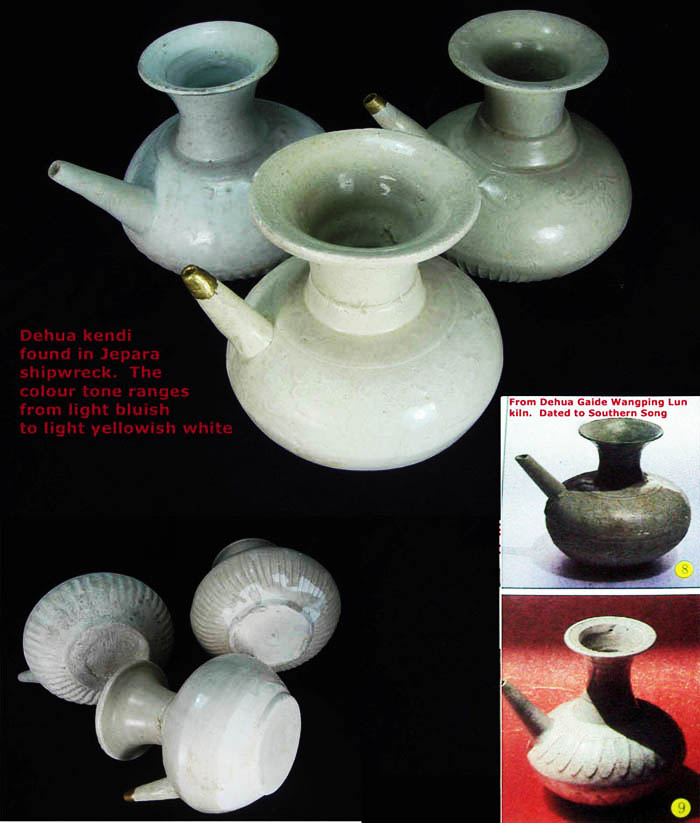
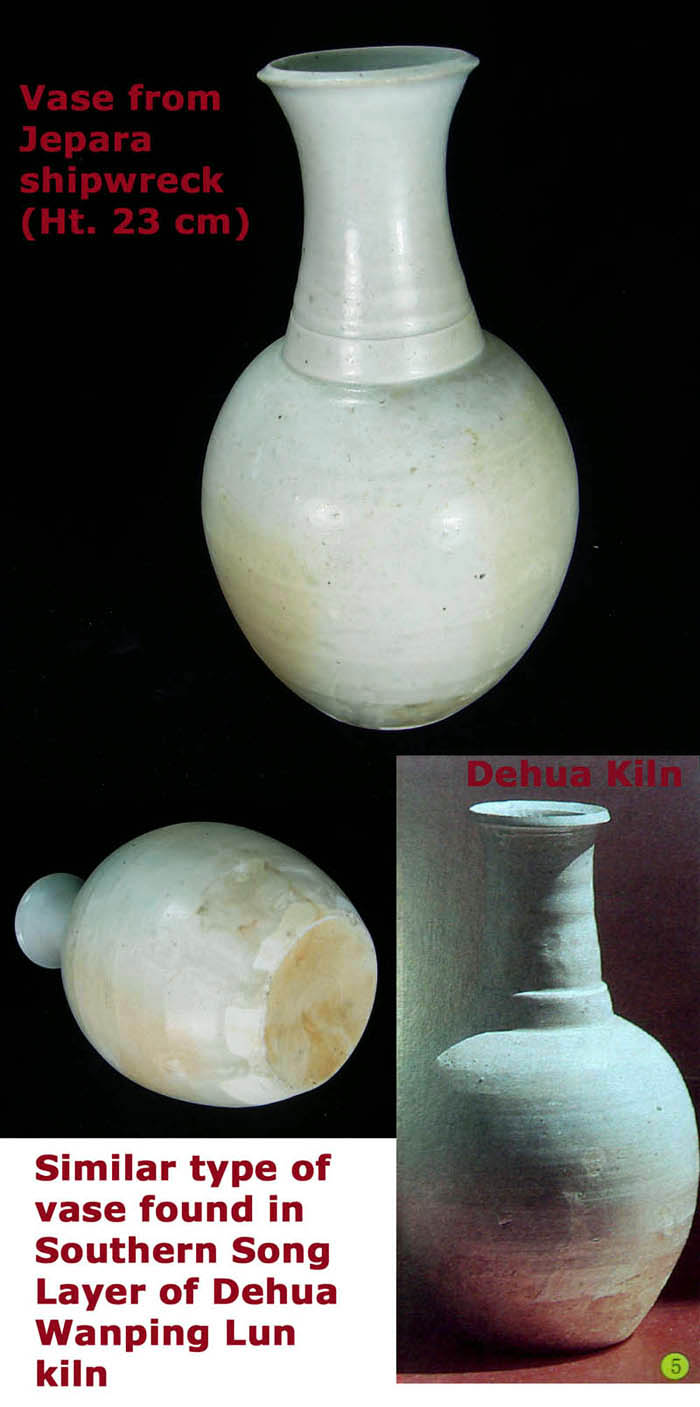
Jepara wreck Qingbai ewer from Minnan kiln


Fujian also produced an interesting group of thinly potted bowls with more elaborate carved/combed floral or waves motif. They usually have a straw colour or grayish white glaze. Usually there is pooling of glaze near the inner and outer rim and sometime even the inner and outer wall. They are widely classified as Qingbai wares. Personally, I think the glaze is intended to imitate the ivory Ding glaze with the typical pooling of teardrop-like glaze effect. Minqing Yi kiln (闽清义窑) has been identified as one of the major kiln that produced such bowls.
A Mingqing Yi kiln greyish straw colour bowl with carved motif from the Nanhai 1 wreck
Temmoku bowls are another very important type of Fujian ceramics.The most famous black temmoku wares were produced in the Jianyang kiln. Jian temmoku were highly praised and treasured by the tea connoisseurs from both China and overseas, especially Japan. Due to the strong overseas demand, coastal kilns especially those in Fuqing and Minhou emerged as major exporters. Visually they are different from Jian temmoku bowls. Majority have a light grayish paste and the glaze is not as thick/glossy and the hares' fur effects are not as distinct and attractive. Temmoku bowls are mainly exported to Japan and not many have been found in Southeast Asia.

Cizao kilns in Jinjiang was a major producer of black/brown glaze wares. The kilns also produced low fired lead green/yellow glaze kendi, censers, basins, plates, jars, ewers. The kendis were specifically made for the Southeast Asian markets. Another unique Cizao product is black glaze wares with deeply carved motif left unglazed.

Late Song/Yuan Cizao sancai
Go to : Ming Trade Ceramics Qing Trade Ceramics Return to: Tang/5 Dynasties Trade ceramics